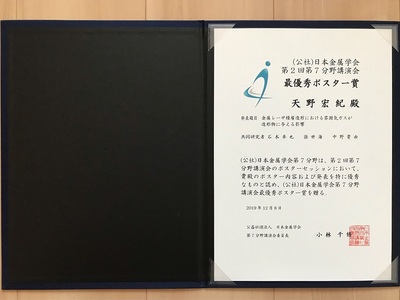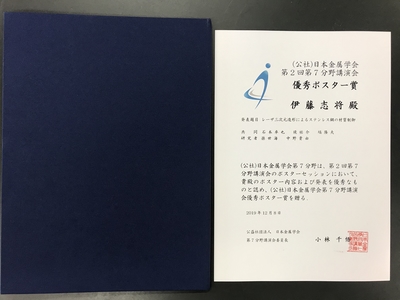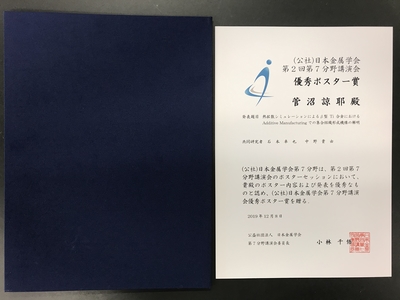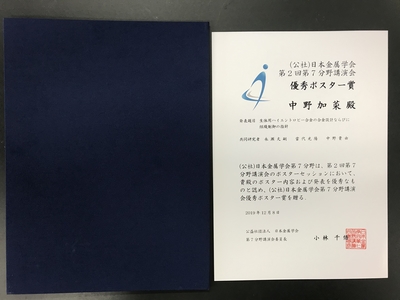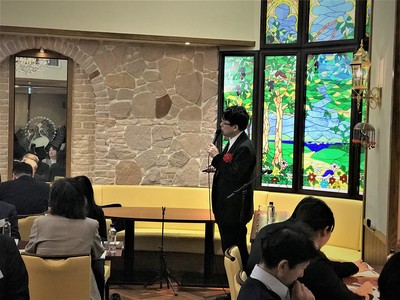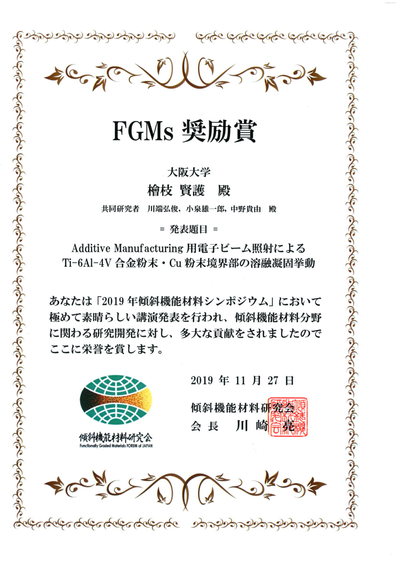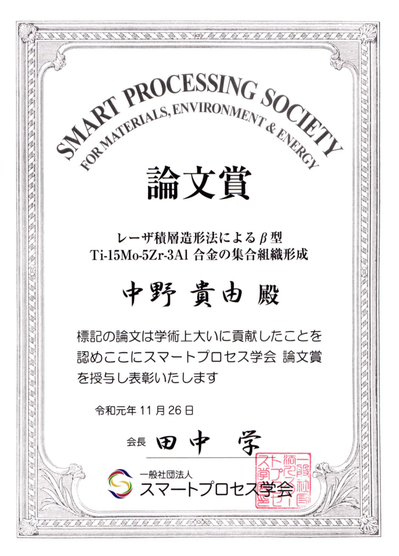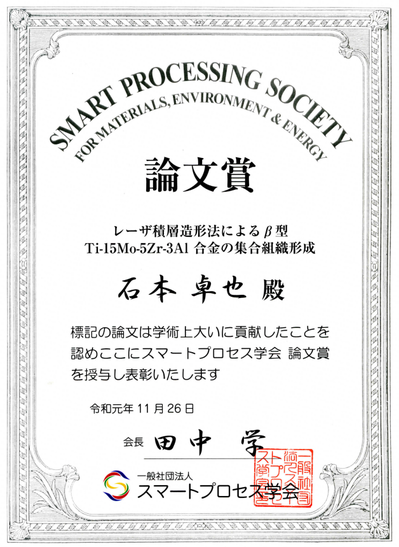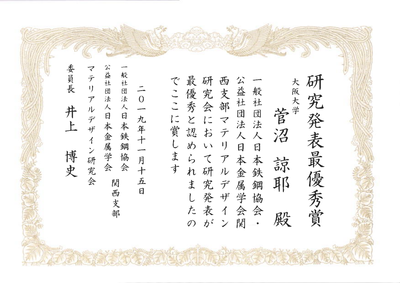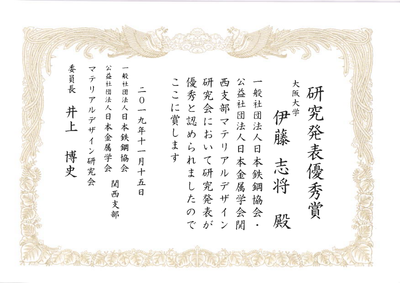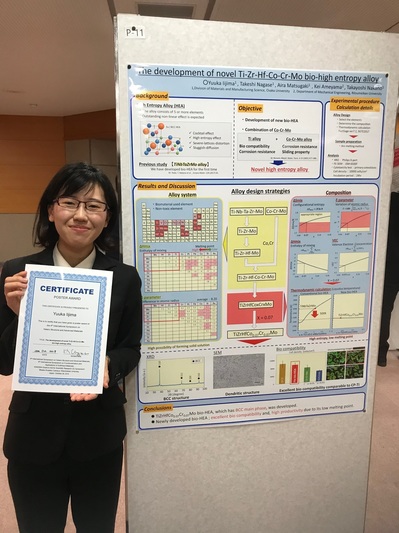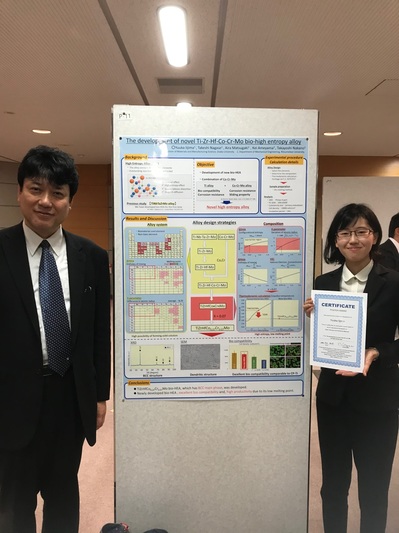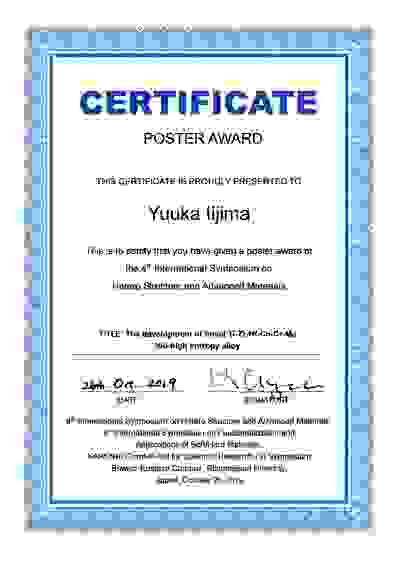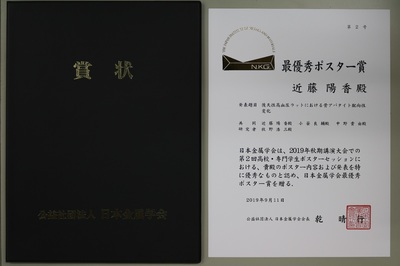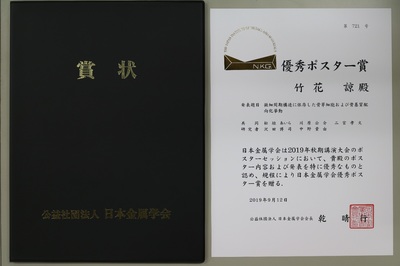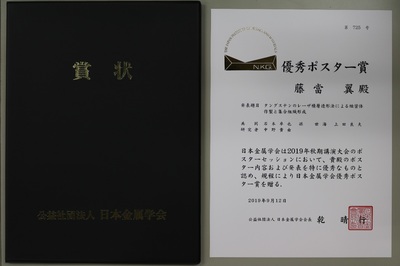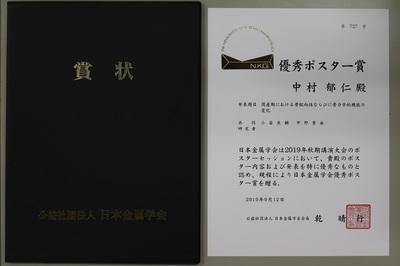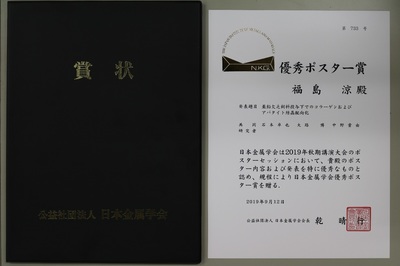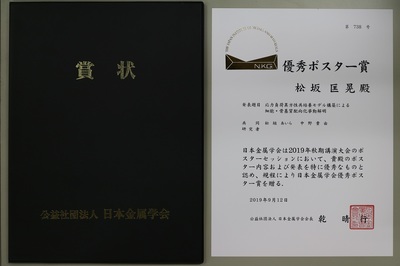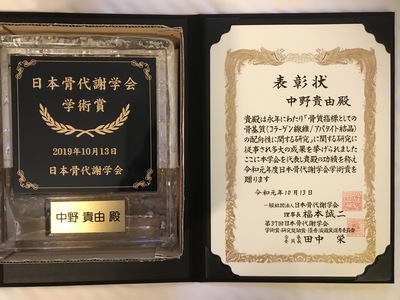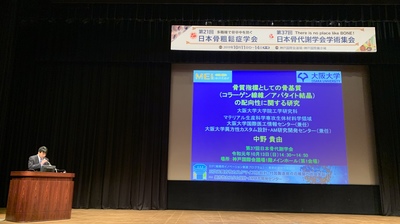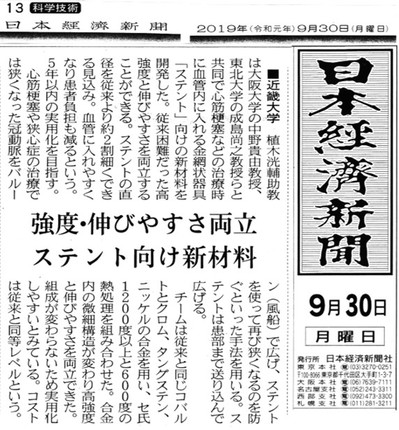What's New
2019(July-December)
-
2019.12.27
-
2019.12.27
-
2019.12.13
-
2019.12.12
-
2019.12.11
-
2019.12.8
-
2019.12.5
-
2019.12.4
-
2019.11.28
-
2019.11.28
-
2019.11.27
-
2019.11.26
-
2019.11.18
-
2019.11.15
-
2019.11.14
-
2019.11.1
-
2019.10.30
-
2019.10.26
-
2019.10.25
-
2019.10.25
-
2019.10.23
-
2019.10.22
-
2019.10.18
-
2019.10.14
-
2019.10.13
-
2019.9.30
-
2019.9.27
-
2019.9.26
-
2019.9.17
-
2019.9.16
-
2019.9.13
-
2019.9.11
-
2019.9.11
-
2019.9.11
-
2019.9.10
-
2019.8.31
-
2019.8.6
-
2019.8.5
-
2019.7.21
-
2019.7.19
-
2019.7.9
-
2019.7.3
-
2019.7.3
-
2019.12.27
A paper on apatite macro-nanostructure in rat masseter muscle in collaboration with Tokyo Dental University has been published in the Journal of hard tissue biology as an open access journal.
Keitaro Arakawa, Satoru Matsunaga, Kunihiko Nojima, Takayoshi Nakano, Shinichi Abe, Masao Yoshinari, Kenji Sueishi:
Micro- and nanostructural characteristics of rat masseter muscle enthuses,
Journal of hard tissue biology, 28 [4], (2019), 365-370.
https://doi.org/10.2485/jhtb.28.365Abstract
The entheses of the masticatory muscles differ slightly from those of the trunk and limb muscles. However, the bones of the skull are subject to various functional pressures, including masticatory force, resulting in a complex relationship between bone structure and muscle function that remains to be fully elucidated. The present study aimed to clarify aspects of masseter muscle-tendon-bone morphological characteristics and local load environment through quantitative analysis of biological apatite (BAp) crystallite alignment and collagen fiber orientation together with histological examination of the entheses. Result of histological observation, the present findings show that, in the entheses of the masseter muscle in the first molar region, tendon attaches to bone via unmineralized fibrocartilage, while some tendon collagen fibers insert directly into the bone, running parallel to the muscle fibers. Furthermore, BAp crystallites in the same region show uniaxial preferential alignment at an angle that matches the insertion angle of the tendon fibers. Conversely, in the entheses of the masseter muscle in the third molar region, the tendon attaches to the bone via a layer of thickened periosteum and chondrocytes. As in the first molar region, the results of bone quality analysis in the third molar region showed BAp crystallite alignment parallel to the orientation of the tendon fibers. This indicates that the local mechanical environment generates differences in enthesis morphology. The present study showed a greater degree of uniaxial BAp crystallite alignment in entheses with direct insertion rather than indirect tendon-bone attachment and the direction of alignment was parallel to the orientation of tendon fibers. These findings suggest that functional pressure from the masseter muscle greatly affects bone quality as well as the morphological characteristics of the enthesis, specifically causing micro- and nanostructural -
2019.12.27
Two papers on Nakano Lab have been published for early publication in Materials Transactions.
Ryosuke Ozasa, Mayuko Nakatsu, Atsushi Moriguchi, Kyohei Sasaki, Takuya Ishimoto, Masahiro Okada, Takuya Matsumoto, Takayoshi Nakano*:
Analysis of Bone Regeneration Based on the Relationship between the Orientations of Collagen and Apatite in Mouse Femur,
Materials Transactions, (2019) Advance View,
https://doi.org/10.2320/matertrans.MT-M2019341
Click here for this PDF.Koji Hagihara*, Takuya Okamoto, Ryohei Ueyama, Michiaki Yamasaki, Yoshihito Kawamura, Takayoshi Nakano:
Loading Orientation Dependence of the Formation Behavior of Deformation Kink Bands in the Mg-Based Long-Period Stacking Ordered (LPSO) Phase,
Materials Transactions, (2019) Advance View,
https://doi.org/10.2320/matertrans.MT-MM2019001
Click here for this PDF. -
2019.12.13
We visited Hitachi Metals GRIT and Dr. Nakano gave a lecture.
Nakano Takayoshi:
Functionalization by control of materials, including internal shape and atomic arrangement, using metal AM -
2019.12.12
Dr. Nakano gave a special lecture at the 1st Design Sharing Conference (SIP Design Sharing).
Takayoshi Nakano:
SIP Phase 1 / Innovative Design and Production Technologies (Sasagusugi PD) for SIP Phase 2 / Materials for Life through Integrated Materials Development System (Mishima PD), by Takayoshi Nakano,
Special Lecture II, December 12, 2019, at the main conference room of the East Office of the National Research and Development Institute -
2019.12.11
An international collaborative study published in Biomaterials Science showed that the ONO-1301-doped nanocomposite modulates cAMP-mediated signaling and induces new bone formation in critical-sized bone defects.
Shruthy Kuttappan, Jun-ichiro Jo, Deepthy Menon Takuya Ishimoto, Takayoshi Nakano, Shantikumar Nair, Yasuhiko Tabata, Manitha Nair*:
ONO-1301 loaded nanocomposite scaffold modulates cAMP mediated signaling and induce new bone formation in critical sized bone defect,
Biomaterials Science, (2019).
DOI: 10.1039/C9BM01352KClick here for this PDF.
Abstract
Recent studies on bone regeneration demonstrate the use of low cost and stable small molecules, which avoid the adverse effect and high cost of growth factors. Herein, we investigate the chemotactic, angiogenic and osteoinductive potential of a prostacyclin analogue, ONO-1301, when delivered through a biomimetic nanocomposite scaffold (nanohydroxyapatite–gelatin matrix reinforced with fibers) for bone tissue regeneration. The small molecule was loaded onto the scaffold in three different concentrations. There was burst release from all the groups of scaffolds within 24 h followed by a sustained release up to 14 days, but the concentration was dependent on loading percentage. ONO-1301 loaded scaffolds augmented the migration, proliferation and osteogenic differentiation of mesenchymal stem cells (MSCs), but increasing the concentration beyond a certain dose did not show any effect. The osteoinduction was mediated through the prostaglandin I2 receptor and cyclic AMP (cAMP) signaling pathway. They also promoted new bone formation in large sized calvarial defects in rats compared to the scaffold alone, but did not show any impact on angiogenesis. Hence, this study suggests the chemotactic and osteoinductive capability of ONO-1301 for the repair and regeneration of critical sized bone defects. -
2019.12.8
Mr. Amano won the best poster award, and Mr. Ito, Mr. Suganuma, and Mr. Nakano of M1 won the best poster award at the 2nd Meeting of the Japan Institute of Metals.
Best Poster Award
○Hiroki Amano, Takuya Ishimoto, Shihai Sun, Takayoshi Nakano:
The effect of ambient gas on the build, in metal laser stacked fabrication,
Best Poster Award at the 2nd Annual Meeting of the Metallurgical Society of Japan, Kobe International Conference Center, December 8, 2019.Poster Award
○Yukinobu Ito, Takuya Ishimoto, Yusuke Tsutsumi, Takao Hanawa, Shihai Sun, Takayoshi Nakano:
Stainless steel material control, by laser three-dimensional modeling,
Poster Award at the 2nd Annual Meeting of the Metallurgical Society of Japan, Kobe International Conference Center, December 8, 2019.○Ryoya Suganuma, Takuya Ishimoto, Takayoshi Nakano:
Mechanism of Microstructure Formation in Additiv Manufacturing of Beta-Ti Alloys by Thermal Diffusion Simulation,
Poster Award at the 2nd Annual Meeting of the Metallurgical Society of Japan, Kobe International Conference Center, December 8, 2019.○Kana Nakano, Takeshi Nagase, Mitsuharu Todai, Takayoshi Nakano:
Guidelines for Alloy Design and Microstructure Control of Biological High Entropy Alloys,
Poster Award at the 2nd Annual Meeting of the Metallurgical Society of Japan, Kobe International Conference Center, December 8, 2019 -
2019.12.5
The Nikkei Sangyo Shimbun published an article on our discovery of osteocyte projections controlled by proteins.
"Regulated by bone cell projection proteins",
Nikkei Sangyo Shimbun morning edition, page 5 (Advanced Technology), December 5, 2019. -
2019.12.4
Dr. Nakano gave a keynote speech at the GE Additive/Arcam-HTL Seminar.
Takayoshi Nakano:
Structure and Material Parameters Control and Functionality, Using Metal AM
December 4, 2019 in Tachikawa -
2019.11.28
Nakano Lab's article was published in the December issue of "Kagaku Kogyo".
Aira Matsugaki and Takayoshi Nakano:
Self-assembly Phenomena in Biological Bone and Its Application to Alternative Materials,
Kagaku Kogyo (Chemical Industry), Vol.70 [12], (2019), pp.44-49.Click here for PDF
-
2019.11.28
Technology Roadmap 2020-2029: All Industries Edition (Nikkei Business Publications, Inc.)," which Dr. Nakano contributed to, has been published.
Takayoshi Nakano (shared author):
"9-7. 3D Additive Manufacturing (3D-AM)",
Technology Roadmap 2020-2029: All Industries, Nikkei BP, November 29, 2019, pp. 378-381, ISBN: 978-4-296-10436-9.
Click here for PDF -
2019.11.27
Mr. Hieda in Koizumi Lab. won the FGMs Encouragement Award for his presentation at the 2019 Symposium on Gradient Functional Materials. This is a collaborate research with Nakano Lab.
Kengo Hieda, Hirotoshi Kawabata, Yuichiro Koizumi, Takayoshi Nakano:
Melting and solidification behavior at the boundary between Ti-6Al-4V alloy powder and Cu powder by electron beam irradiation for additive manufacturing,
Functionally Gradient Materials FORUM of Japan [FGMs Encouragement Award], "2019 Symposium on Gradient Functional Materials", Nov. 27, 2019. -
2019.11.26
A paper in Nakano Lab. won the Best Paper Award from Smart Processing Society for Materials, Environment & Energy.
Takuya Ishimoto, Jumpei Yasutomi, Shota Sugimoto, Takayoshi Nakano:
Microstructure formation of β-type Ti-15Mo-5Zr-3Al alloy by laser additive manufacturing,
Journal of Smart Processing Society for Materials, Environment & Energy, 7 [6], (2018), pp. 229-232. -
2019.11.18
A paper on our laboratory's discovery of factors that elongate osteocytes has been published in Materials Science & Engineering C.
Aira Matsugaki, Daisuke Yamazaki, Takayoshi Nakano∗:
Selective patterning of netrin-1 as a novel guiding cue for anisotropic dendrogenesis in osteocytes,
Materials Science & Engineering C, 108, (2020), 110391: 1-6.
https://doi.org/10.1016/j.msec.2019.110391【Abstract】
Although protein patterning approaches have found widespread applications in tuning surface characteristics of biomaterials, selective control of growth in cell body and dendrites utilizing such platforms remains difficult. The functional roles assumed by cell body and dendrites in a physiological milieu have extremely high specificity. In particular, osteocytes embedded inside the mineralized bone matrix are interconnected via dendritic cell processes characterized by an anisotropic arrangement of the lacunar-canalicular system, where the fluid-flow inside the canaliculi system regulates the mechanoresponsive functionalization of bone. Control of cellular networks connected by dendritic cell processes is, therefore, imperative for constructing artificially controlled bone-mimetic structures and as an extension, for gaining insights into the molecular mechanisms underlying dendrogenesis inside the mineralized bone matrix. Here, we report an innovative strategy to induce controlled elongation of cell body or dendritic process structures in selective directions by using the inkjet printing technique. Artificial runways employing netrin-1, inspired by neural architecture, were utilized to trigger controlled elongation in the osteocyte dendritic processes in desired directions. This is the first report, to the best of our knowledge, demonstrating that anisotropic dendrogenesis of osteocytes can be controlled with selective patterning of extracellular proteins, specifically via the axon guidance ligand netrin-1.Click here for PDF.
-
2019.11.15
Mr. Suganuma and Mr. Ito won the Best Presentation Award and the Best Presentation Award, respectively, at the Kansai Branch Meeting of The Iron and Steel Institute of Japan and The Japan Institute of Metals and Materials.
Ryoya Suganuma, Takuya Ishimoto, Yoichi Takagishi, Tatsuya Yamagami, and Takayoshi Nakano:
Elucidation of the Formation Mechanism of β-Ti Alloy Aggregate Structure by SLM with Thermal Diffusion Simulation.Yukinobu Ito, Takuya Ishimoto, Yusuke Tsutsumi, Takao Hanawa, Shi-hai Sun and Takayoshi Nakano:
Microstructure Control and Material Property Improvement of Stainless Steel by Laser Additive Manufacturing Method. -
2019.11.14
Nakano Lab's article was published in "Zairyo" magazine.
Noriyuki Hisamori, Takuya Ishimoto, Takayoshi Nakano:
Frontiers of Additive Manufacturing in Biomedical Materials,
Materials, 68, [10], 798-803 (2019).Click here for PDF
-
2019.11.1
Nakano Lab's article of 3D printer for medical was featured in The Japan Iron and Steel Institute.
Takayoshi Nakano, Takuya Ishimoto:
Application of metal 3D printer technology to medical devices: shape, microstructure, and atomic arrangement control,
Fuerum, 24 [11], (2019), 21(687)-30(696).Click here for PDF
-
2019.10.30
Two commentary articles related to Nakano Lab were published in the October issue of Titanium Magazine.
Seong-Ho Lee.
Fabrication of Osteogenesis-Promoting Novel Biomaterials by Titanium/Bioactive Glass Composites Using Additive Manufacturing Method,
Titanium, 64 [4], October, (2019), pp.36(276).Click here for PDF.
Ken Zhao, Hiroyuki Yasuda, Mitsuharu Todai, Minoru Ueda, Masao Takeyama, and Takayoshi Nakano:.
Peculiar microstructure and mechanical properties of TiAl alloy components in electron beam three-dimensional additive manufacturing process,
Titanium, 64 [4], October, (2019), pp. 50(290)-56(296).Click here for PDF.
-
2019.10.26
Mrs. Iijima won the 2nd prize (Silver) in the poster award at Harmonic 2019 4th International Symposium on Hetero Structure and Advanced Materials held at Ritsumeikan University.
○Yuuka Iijima Takeshi Nagase , Aira Matsugaki, Kei Ameyama, Takayoshi Nakano:
The development of novel Ti-Zr-Hf-Co-Cr-Mo bio-high entropy alloy,
A silver poster award of the 4th International Symposium on Hetero Structure and Advanced Materials, October 26th, 2019, Rohm Memorial Hall, Biwako-Kusatsu Campus, Ritsumeikan University, Kusatsu, Shiga, JAPAN.Commemorative photo of the award
Commemorative photo with Dr. Nakano
-
2019.10.25
Dr. Nakano's commentary will be featured in the November issue of Mechanical Engineering.
Takayoshi Nakano
Formation of specific microstructure and expression of function by metal 3D printer,
Mechanical Engineering November, Vol.67, No.12, Nikkan Kogyo Shimbun, (2019), pp.21-27.Click here for PDF
-
2019.10.25
The article, "Professor Takayoshi Nakano wins the Japanese Society for Bone and Metabolism Research Academic Award," has been published.
Click here for this article.
-
2019.10.23
The commentary was published in "Biomaterials".
Aira Matsugaki and Takayoshi Nakano:
Control of Cell and Bone Orientation by Surface Morphology Specific Orthogonal Bone Orientation Phenomena by Nano-Oriented Grooves,
Biomaterials - Biomaterials, vol. 37, no. 4, pp. 270-271.Click here for PDF
-
2019.10.22
Our papers on Ti-Zr-Hf-Cr-Mo alloy and Ti-Zr-Hf-Co-Cr-Mo alloy, which are newly designed as biomaterials, have been published as open access papers in Materials Science and Engineering C.
Takeshi Nagase, Yuuka Iijima, Aira Matsugaki, Kei Ameyama, Takayoshi Nakano*:
Design and fabrication of Ti–Zr-Hf-Cr-Mo and Ti–Zr-Hf-Co-Cr-Mo high-entropy alloys as metallic biomaterials,
Materials Science and Engineering C, (2019), 110322, on line.
https://doi.org/10.1016/j.msec.2019.110322Abstract
Novel TiZrHfCr0.2Mo and TiZrHfCo0.07Cr0.07Mo high-entropy alloys for metallic biomaterials (bio-HEAs) were developed based on the combination of Ti-Nb-Ta-Zr-Mo alloy system and Co-Cr-Mo alloy system as commercially-
used metallic biomaterials. Ti-Zr-Hf-Cr-Mo and Ti-Zr-Hf-Co-Cr-Mo bio-HEAs were designed using (a) a tree-like diagram for alloy development, (b) empirical alloy parameters for solid-solution-phase formation, and © thermodynamic calculations focused on solidification. The newly-developed bio-HEAs overcomes the limitation of classical metallic biomaterials by the improvement of (i) mechanical hardness and (ii) biocompatibility all together. The TiZrHfCr0.2Mo and TiZrHfCo0.07Cr0.07Mo bio-HEAs showed superior biocompatibility comparable to that of commercial-purity Ti. The superior biocompatibility, high mechanical hardness and low liquidus temperature for the material processing in TiZrHfCr0.2Mo and TiZrHfCo0.07Cr0.07Mo bio-HEAs compared with the Ti-Nb-Ta-Zr-Mo bio-HEAs gave the authenticity of the application of bio-HEAs for orthopedic implants with multiple functions. -
2019.10.18
We received The Japan Institute of Metals and Materials The Metals Best Poster Awards.
〇Haruka Kondo, Ryosuke Ozasa, Takayoshi Nakano, Kozo Makino:
Changes in bone apatite orientation in acquired hypertensive rats,
The Japan Institute of Metals and Materials The Metals Best Poster Awards, "High School and College of Technology Student Poster Presentation" , Okayama University, September 11, 2019.〇Ryo Takehana, Aira Matsukaki, Kosuke Kawahara, Takafumi Ninomiya, Hiroshi Sawada, and Takayoshi Nakano:
Microperiodic structure-dependent orientation behavior of osteoblasts and bone matrix,
The 33rd Annual Meeting of the Japan Institute of Metals and Materials, The Japan Institute of Metals and Materials The Metals Best Poster Awards, Okayama University, September 11, 2019.〇Tsubasa Todo, Takuya Ishimoto, Shihai Sun, Yoshio Ueda, Takayoshi Nakano:
Fabrication and microstructure formation of tungsten dense body by laser lithography,
The 33rd Annual Meeting of the Japan Institute of Metals and Materials, The Japan Institute of Metals and Materials The Metals Best Poster Awards, Okayama University, September 11, 2019.〇Fumihito Nakamura, Ryosuke Ozasa, Takayoshi Nakano:
Changes in bone orientation and osteomechanical function during the perinatal period,
The 33rd Annual Meeting of the Japan Institute of Metals and Materials, The Japan Institute of Metals and Materials The Metals Best Poster Awards, Okayama University, September 11, 2019.〇Ryo Fukushima, Takuya Ishimoto, Hiroshi Oji, Takayoshi Nakano:
Orientation of collagen and apatite crystals under zinc-deficient diet,
The 33rd Annual Meeting of the Japan Institute of Metals and Materials, The Japan Institute of Metals and Materials The Metals Best Poster Awards, Okayama University, September 11, 2019.〇Tadaaki Matsuzaka, Aira Matsukaki, Takayoshi Nakano:
Elucidation of the orientation behavior of cells and bone matrix by constructing an anisotropic co-culture model under stress loading,
The 33rd Annual Meeting of the Japan Institute of Metals and Materials, The Japan Institute of Metals and Materials The Metals Best Poster Awards, Okayama University, September 11, 2019. -
2019.10.14
A collaborate research results with the Department of Orthopaedic Surgery, Osaka University were published in Bone.
Kazuma Kitaguchi, Masafumi Kashii, Kosuke Ebina, Takashi Kaito, Rintaro Okada, Takahiro Makino, Etani Yuki, Takuya Ishimoto, Takayoshi Nakano, Hideki Yoshikawa:
The combined effects of Teriparatide and Anti-RANKL Monoclonal Antibody on Bone Defect Regeneration in Ovariectomized Mice,
Bone, (2019), on line.Abstract
Objective
The purpose of this study was to investigate the combined effects of teriparatide (TPTD) and anti-murine receptor activator of nuclear factor-κB ligand monoclonal antibody (anti-RANKL Ab) on both cancellous and cortical bone healing in ovariectomized mice.Methods
Thirteen-week-old mice were divided into the sham-operated group (n = 11) or the ovariectomized group (n = 44). At 1 month post-operation, all mice underwent bone defect surgery on the left femoral metaphysis (cancellous bone healing model) and right femoral mid-diaphysis (cortical bone healing model). After creating the bone defects, all ovariectomized mice were assigned to one of four groups to receive 1) saline (5 times a week; CNT group), 2) TPTD (40 μg/kg 5 times a week; TPTD group), 3) anti-RANKL Ab (5 mg/kg once; Ab group), or 4) a combination of TPTD and anti-RANKL Ab (COMB group). The following analyses were performed: Time-course microstructural analysis of healing in both cancellous and cortical bone in the bone defect, measuring the volumetric bone mineral density and the cortical bone thickness of the tibia as a representative of whole body bone with the use of micro-computed tomography, and histological analysis.Results
Regeneration of cancellous bone volume in the COMB group was the highest among the four groups, and combined treatment accelerated the formation of medullary callus during the early phase of bone regeneration. On the other hand, there were no significant differences in the regeneration of cortical bone volume during the early phase of bone regeneration among the four groups. Furthermore, lamellar bone was not well identified in the all four groups. Volumetric bone mineral density in the tibia in the COMB group was significantly higher compared with that in the CNT and TPTD groups and tended to be higher compared with that in the Ab group. The mean values of cortical bone thickness in the TPTD and COMB groups were significantly higher than that in the CNT group.Conclusion
In a mouse model of postmenopausal osteoporosis, combination therapy of TPTD and anti-RANKL Ab accelerates regeneration of cancellous bone more effectively than either agent alone during the early phase of bone regeneration.Click here for this paper
-
2019.10.13
At the 37th Annual Meeting of the Japanese Society of Bone Metabolism (held jointly with the 21st Annual Meeting of Japan Osteoporosis Society) (Kobe International Conference Center), Dr. Nakano became the second person in the School of Engineering to rec
Takayoshi Nakano:.
2019 Academic Award of the Japanese Society of Bone Metabolism Research (Basic), for his longtime contribution to "Research on the orientation of bone matrix (collagen fibrils/apatite crystals) as a bone quality indicator",
at Kobe International Conference Hall, October 13, 2019.Commemorative plaque and certificate
Dr. Nakano's award lecture
-
2019.9.30
In the morning edition of the Nihon Keizai Shimbun, it was reported that a collaborate research with Dr. Ueki (Kinki Univ.) and Prof. Narushima (Tohoku Univ.) has succeeded in significantly improving the performance of coronary stents by using a new two-s
Kosuke Ueki, Takayoshi Nakano, Naoyuki Narushima:
New material for stents that combines strength and elongation,
September 30, 2019, Nihon Keizai Shimbun, Morning Edition, page 13 (Science & Technology).Click here for the electronic version of the article.
-
2019.9.27
Two explanatory articles from Nakano Research Institute will appear in the November issue of Forum (The Iron and Steel Institute of Japan) and in the November issue of Kikai Gijutsu (Nikkan Kogyo Shuppan).
〇Takayoshi Nakano, Takuya Ishimoto:
Application of Metal 3D Printer Technology to Medical Devices: Shape, Microstructure, and Atomic Arrangement Control,
Serial article, Special issue on "3D printer opens the way to the next generation manufacturing", Forum, November issue (2019)〇Takayoshi Nakano:
Formation of specific tissues and expression of functions by metal 3D printer,
Special Issue on "Metal 3D printer opens up the way to manufacturing - Advanced technology for additive manufacturing", Mechanical Technology, November (2019). -
2019.9.26
The commentary was published in the feature article "Metallic Biomaterials" in the September issue of Special Steel.
Takayoshi Nakano:
Titanium and titanium alloys,
Special Steel, Vol. 68, No. 5 [September], (2019), pp. 23-26.Click here for this PDF.
-
2019.9.17
The commentary was published in the special feature "Recent Trends in Metalloid Additive Manufacturing Technology" in the Journal of Japan Foundry Engineering Society "Foundry Engineering".
Takeshi Nagase, Mitsuyo Toshiro, and Takayoshi Nakano:
Additive manufacturing of titanium alloy using pure elemental powders,
Journal of Japan Foundry Engineering Society, Special Issue on Recent Trends in Metal Laminated Molding Technology, 91 [9], (2019), pp. 627-633.Click here for this PDF.
-
2019.9.16
As a collaborative research between Kindai University, Tohoku University, and Osaka University, a paper on a heat treatment process that combines high strength and high ductility with expandability applicable to stents has been published in Materials Scie
Kosuke Ueki*, Soh Yanagihara, Kyosuke Ueda, Masaaki Nakai, Takayoshi Nakano, Takayuki Narushima:
Overcoming the strength-ductility trade-off by the combination of static recrystallization and low-temperature heat-treatment in Co-Cr-W-Ni alloy for stent application,
Materials Science and Engineering A, 766, (2019) paper# 138400: 1-11 -
2019.9.13
Members of Nakano Lab. participated in the 2019 Autumn Meeting of The Japan Institute of Metals and Materials(165th) held at Okayama University on 9/11-9/13.
Dr. Nakano served as the Vice President of the Japan Institute of Metals and the Chairperson of the Conference Committee, and chaired the K3 Session on Recent Trends in Materials Technology Contributing to the Automotive Revolution, Dr. Ishimoto chaired the S7 Session on Materials Science and Technology for Additive Manufacturing in Medicine and Welfare, and Dr. Ozasa chaired the Biomaterials Design Development and Clinical Practice (1) Session.
The presentations are as follows.The Japan Institute of Metals and Materials Murakami Young Researcher Award Lecture
○Takuya Ishimoto
Research on functionalization of biological bones and biomaterials based on metallic materials engineeringOral Presentation
○Takuya Ishimoto, Junpei Yasutomi, Shihai Sun, Takayoshi Nakano:
Formation of Specific Assembly Structure and Mechanical Properties of Inconel 718 by Laser Additive Manufacturing Method○Takuya Ishimoto, Junpei Yasutomi, Shihai Sun, Takayoshi Nakano:
Microstructural changes in bone due to malignant bone tumor formation○Ryosuke Ozasa, Takayoshi Nakano:
Effect of blood pressure change on bone microstructure○Shihai Sun, Koji Hagiwara, Takuya Ishimoto, Takayoshi Nakano:
Comparison of crystallographic texture and mechanical property of Ti-15Mo-5Zr-3Al alloy fabricated by electron and laser beam melting○Yuka Iijima, Taketsugu Nagase, Aira Matsugaki, Takuya Ishimoto, Megumi Ameyama, Takayoshi Nakano:
Microstructure and properties of Ti-Zr-Hf-Co-Cr-Mo biological high-entropy alloys○Natsuki Okuda, Takuya Ishimoto, Takayoshi Nakano:
A proposal for anisotropic bone reconstruction using bone cross-sectional anisotropy○Yoshiya Kobayashi, Takuya Ishimoto, Manabu Ito, Takayoshi Nakano:
Effect of autogenous bone grafting on bone integrity formed in spinal cages○Kyohei Sasaki, Ryosuke Ozasa, Takayoshi Nakano:
Elucidation of the mechanism of bone orientation by ApoE gene○Tatsuki Harada, Aira Matsugaki, Takayoshi Nakano:
Regulatory mechanism of bone orientation based on dynamic interaction with cancer cells○Atsushi Moriguchi, Ryosuke Ozasa, Takeshi Moriishi, Toshihiro Miyazaki, Hisafumi Komori, Takayoshi Nakano:
Elucidation of the mechanism of apatite orientation using a regenerative bone model○Yukinobu Ito, Takuya Ishimoto, Yusuke Tsutsumi, Takao Hanawa, Shihai Sun, Takayoshi Nakano
Control of aggregate structure and improvement of material properties of stainless steel by metal AM○Ryoya Suganuma, Takuya Ishimoto, Yoichi Takagishi, Tatsuya Yamagami, Takayoshi Nakano
Clarification of formation mechanism of β-type Ti alloy microstructure by laser lamination method using thermal diffusion simulation○Yuichiro Koizumi, Takayoshi Nakano:
Computer simulation for metal additive manufacturing○Masakazu Tane, Norihiko Okamoto, Koji Inoue, Martin Luckabauer, Kosuke Nagai, Toru Sekino, Takayoshi Nakano, Satoshi Ichitsubo:
Non-diffusion isothermal ω-transformation in β-type titanium alloys induced by frozen alloy composition fluctuations○Hiroki Narimoto, Koji Hagiwara, Takayoshi Nakano, Michiaki Yamazaki, Yoshihito Kawamura:
Control of kink zone formation and distribution in Mg-based LPSO phase○Ken Zhao, Masahiro Sakata, Hiroyuki Yasuda, Mitsuharu Todai, Minoru Ueda, Masao Takeyama, Takayoshi Nakano:
Ductility improvement of TiAl alloy by controlling specific banded microstructure using electron beam three-dimensional lamination○Hajime Kawabata, Ken Zhao, Hiroyuki Yasuda, Mitsuharu Todai, Minoru Ueda, Masao Takeyama, Takayoshi Nakano:
Effect of shape on microstructure of TiAl alloys fabricated by electron beam 3D additive manufacturing○Jun Kubo, Yuichiro Koizumi, Takuya Ishimoto, Takayoshi Nakano:
Microscopic simulation of metal powder additive manufacturing○Yusuke Tsutsumi, Takuya Ishimoto, Kyosuke Ueda, Tetsushi Kuze, Shimpei Maruyama, Akira Matsugaki, Chen Peng, Maki Roda, Kosuke Ueki, Akihiko Yanagitani, Hideki Katayama, Takayoshi Nakano, Takao Hanawa:
High Corrosion Resistance of Martensitic Stainless Steel by Laser Additive Manufacturing○Kosuke Ueki, Hajime Yanagihara, Kyosuke Ueda, Masaaki Nakai, Takayoshi Nakano, Naoyuki Narushima:
Improvement of strength and ductility by static recrystallization and low temperature heat treatment process in Co-Cr-W-Ni alloy for biological applications○Ryohei Ueyama, Koji Hagiwara, Tsuyoshi Mayama, Michiaki Yamazaki, Yoshihito Kawamura, Takayoshi Nakano:
Investigation of kink zone formation behavior in Mg-based LPSO phase by calculation and experiment○Hirotaka Odo, Ken Zhao, Hiroyuki Yasuda, Mitsuyo Toshiro, Minoru Ueda, Masao Takeyama, Takayoshi Nakano:
Improvement of Room Temperature Fatigue Properties of TiAl Alloy Fabricated by Electron Beam 3D Additive Manufacturing○Takumi Maeda, Yuichiro Koizumi, Hirotoshi Kawabata, Takuya Ishimoto, Kota Kimura, Shihai Sun, Takayoshi Nakano:
Melt-solidification behavior of Ti-15Mo-5Zr-3Al alloy by laser scanning for powder bed melt-bonded AMThe 33rd Poster Presentation
○Ryo Takehana, Aira Matsukaki, Kosuke Kawahara, Takafumi Ninomiya, Hiroshi Sawada, Takayoshi Nakano:
Microstructure-dependent orientation behavior of osteoblasts and bone matrix○Tsubasa Todo, Takuya Ishimoto, Shihai Sun, Yoshio Ueda, Takayoshi Nakano:
Fabrication of Dense Body and Assembly Tissue Formation by Laser Additive Manufacturing of Tungsten○Fumihito Nakamura, Ryosuke Kozasa, Takayoshi Nakano:
Changes in bone orientation and osteomechanical function during the perinatal period○Ryo Fukushima, Takuya Ishimoto, Hiroshi Oji, Takayoshi Nakano:
Orientation of collagen and apatite crystals under zinc-deficient diet○Tadaaki Matsuzaka, Aira Matsugaki, Takayoshi Nakano:
Elucidation of the orientation behavior of cells and bone matrix by constructing an anisotropic co-culture model under stress load○Yusuke Yamaoka, Ryosuke Ozasa, Takayoshi Nakano:
Changes in bone microstructure due to abnormal phosphorus metabolism2nd Poster Presentation by High School and College of Technology Students
Yuka Kondo, Ryosuke Ozasa, Takayoshi Nakano, Kozo Makino:
Changes in Bone Apatite Orientation in Acquired Hypertensive Rats -
2019.9.11
Dr. Ishimoto was awarded "The 16th Japan Institute of Metals and Materials Murakami Young Researcher Award" at the 2019 Fall Meeting of the Japan Institute of Metals (165th).
Takuya Ishimoto:
Research on the functionalization of biological bones and materials based on metallic materials engineering -
2019.9.11
The Matelia manuscript written by Nakano Lab. was awarded the Materia Japan Award at the 2019 Fall Meeting of the Japan Institute of Metals (165th), and Dr. Todai received the award on behalf of the group.
Mitsuharu Todai, Takuya Ishimoto, Aira Matsugaki, Takayoshi Nakano:
Construction of design guidelines for the development of next-generation biomaterials -
2019.9.11
Ms. Haruka Kondo, who is a high school student, Mr. Takehana (M1), Mr. Todo(M1), Mr. Nakamura(M1), Mr. Fukushima (B4), and Mr. Matsuzaka (B4) won The Japan Institute of Metals and Materials The Metals Best Poster Award.
○Haruka Kondo, Ryosuke Ozasa, Takayoshi Nakano, Kozo Makino:
Changes in bone apatite orientation in acquired hypertensive rats○Ryo Takehana, Aira Matsugaki, Kosuke Kawahara, Takafumi Ninomiya, Hiroshi Sawada, Takayoshi Nakano:
Microperiodic structure-dependent orientation behavior of osteoblasts and bone matrix○Tsubasa Todo, Takuya Ishimoto, Shihai Sun, Yoshio Ueda, Takayoshi Nakano:
Fabrication of Dense Body and Assembly Tissue Formation by Laser Additive Manufacturing of Tungsten○Fumihito Nakamura, Ryosuke Ozasa, Takayoshi Nakano:
Changes in bone orientation and osteomechanical function during the perinatal period○Ryo Fukushima, Takuya Ishimoto, Hiroshi Oji, Takayoshi Nakano:
Orientation of collagen and apatite crystals under zinc-deficient diet○Tadaaki Matsuzaka, Aira Matsugaki, Takayoshi Nakano:
Elucidation of the orientation behavior of cells and bone matrix by constructing an anisotropic co-culture model under stress loadingTranslated with www.DeepL.com/Translator (free version)
-
2019.9.10
An article about Nakano Laboratory was posted on the website and SNS of the School of Engineering and Graduate School of Engineering, Osaka University.
Here, you can see our laboratory's research scenes and 3D printed objects through videos and other media.
Click here for the website of the Graduate School of Engineering, Osaka University
Click here for the Facebook page of the Graduate School of Engineering, Osaka University
Click here for the Instagram of Osaka University, School of Engineering and Graduate School of Engineering
Click here for the Twitter page of the Graduate School of Engineering, Osaka University -
2019.8.31
Special Issue on Latest Research and Development of Structural and Functional Titanium-Based Materials, organized by Prof. Shinya, Prof. Nakano and others, was published in the September issue of Materials Transactions, and four papers related to Nakano L
Special Issue on Latest Research and Development of Structural and Functional Titanium-Based Materials
PREFACE
Titanium (Ti)-based materials are gaining a lot of attentions in fields including aerospace, medical devices, welfare goods, antibacterial materials, consumer goods, chemical plants, electric generation, ocean thermal energy conversion, and armors. Using an additive manufacturing (AM) to make complex shaped products of Ti-based materials is a topic of research globally. For AM of Ti-based materials, not only processing, but also fundamental research on topics such as solidification, heat flow, crystal graphic analysis, and alloy design are becoming more popular. National projects including Ti-based materials managed by ISMA (Innovative Structural Materials Association), SIP (Cross-materials Strategic Innovation Program) and TRAHAM (Technology Research Association for Future Additive Manufacturing Unions), are also in progress. The 14th World Conference on Titanium, which is the largest international conference on Ti-based materials, was held from June 1014, 2019 at Nantes in France. Therefore, it is now a good time to publish a special issue on the latest topics related to Ti-based materials. Approximately 20 fruitful original technical papers related to all the fields of Ti-based materials including air craft structures and biomedical implants, their surface modifications to enhance the biocompatibility, AM processing, low cost manufacturing, deformation behaviors, and mechanical properties, and effects of low cost elements on their properties are included in this special issue. We are grateful to all the authors for their contributions. We hope this special issue helps to solve important questions related to Ti-based materials.July 23, 2019
Guest Editors: Takayoshi Nakano1, Takayuki Narushima2, Takao Hanawa3, Masato Ueda4, Yoko Yamabe-Mitarai5, Tadashi Furuhara6, Hideki Hosoda7, Mitsuo Niinomi8
1 Professor, Graduate School of Osaka University,
2 Professor, Graduate School of Tohoku University,
3 Professor, Institute for Biomaterial Engineering, Tokyo Medical and Dental University,
4 Professor, Kansai University, Faculty of Chemistry,
5 Deputy Director, Research Center for Structural Materials, National Institute for Materials Science (NIMS),
6 Professor, Institute for Materials Research, Tohoku University,
7 Professor, Institute of Innovative Research, Tokyo Institute of Technology
8 Professor Emeritus, Tohoku University〇Takayoshi Nakano, Takayuki Narushima, Takao Hanawa, Masato Ueda, Yoko Yamabe-Mitarai, Tadashi Furuhara, Hideki Hosoda, Mitsuo Niinomi:
PREFACE-Special Issue on Latest Research and Development of Structural and Functional Titanium-Based Materials, Materials Transactions, 60 [9], (2019), 1732.1) M. Niinomi, T. Akahori, M. Nakai, Y. Koizumi, A. Chiba, T. Nakano, T.Kakeshita, Y. Yamabe-Mitarai, S. Kuroda, N. Motohashi, Y. Itsumi and T.Choda:
Quantitative and Qualitative Relationship between Microstructural Factors and Fatigue Lives under Load- and Strain-Controlled Conditions of Ti5Al2Sn2Zr4Cr4Mo (Ti-17) Fabricated Using a 1500-ton Forging Simulator,
Materials Transactions, 60 [9], (2019), 1740-1748.
Click here for this paper.2) Qiang Li, Qiang Qi, Junjie Li, Masaaki Nakai, Mitsuo Niinomi, Yuichiro Koizumi, Daixiu Wei, Kenta Yamanaka, Takayoshi Nakano, Akihiko Chiba, Xuyan Liu and Deng Pan:
Low Springback and Low Young’s Modulus in Ti29Nb13Ta4.6Zr Alloy Modified by Mo Addition, Materials Transactions, 60 [9], (2019), 1755-1762.
Click here for this paper.3) Qiang Li, Xufeng Yuan, Junjie Li, Pan Wang, Masaaki Nakai, Mitsuo Niinomi, Takayoshi Nakano, Akihiko Chiba, Xuyan Liu and Deng Pan:
Effects of Fe on Microstructures and Mechanical Properties of Ti15Nb25Zr(0, 2, 4, 8)Fe Alloys Prepared by Spark Plasma Sintering, Materials Transactions, 60 [9], (2019), 1763-1768.
Click here for this paper.4) Sungho Lee, Jong Yeong Oh, Soichiro Mukaeyama, Shi-Hai Sun, TakayoshiNakano*
: Preparation of Titanium Alloy/Bioactive Glass Composite for Biomedical Applications via Selective Laser Melting, Materials Transactions,
60 [9], (2019), 1779-1784.
Click here for this paper.
Click here for this PDF. -
2019.8.6
Our paper on microstructure and mechanical properties of Ti-xNb-2Fe Alloys has been published in "Journal of Materials Engineering and Performance".
Qiang Li, Pu Miao, Junjie Li, Meifeng He, Masaaki Nakai, Mitsuo Niinomi, Akihiko Chiba, Takayoshi Nakano, Xuyan Liu, Kai Zhou, and Deng Pan:
Effect of Nb Content on Microstructures and Mechanical Properties of Ti-xNb-2Fe Alloys,
Journal of Materials Engineering and Performance, (2019),
doi.org/10.1007/s11665-019-04250-5Abstract
β-Type Ti-Nb-based alloys exhibit satisfactory biocompatibility and low Young's modulus for biomedical applications. The microstructure and mechanical properties of a series of Ti-(14, 16, 18, 20, 22, 24)Nb-2Fe alloys fabricated by arc melting were investigated by XRD, optical microscopy, and tensile tests. Both ω and α″ phases existed in the Ti-14Nb-2Fe alloy, while just a single β phase existed in the other alloys. Twinning is an important deformation mechanism that causes work hardening and twinning-induced plasticity. It was found in the Ti-(14, 16, 18, 20)Nb-2Fe alloys and not in the Ti-22Nb-2Fe alloy. The Ti-14Nb-2Fe alloy exhibited the highest tensile strength and the highest Young's modulus owing to the existence of the ω phase. The tensile strength decreased gradually from 830 MPa (highest) for the Ti-14Nb-2Fe alloy to 540 MPa (lowest) for the Ti-24Nb-2Fe alloy with an increase in the Nb content. The Young's modulus decreased from 90 GPa for the Ti-14Nb-2Fe alloy to 63 GPa for the Ti-22Nb-2Fe alloy and then increased to 71 GPa for the Ti-24Nb-2Fe alloy. Elongation shows the same trend as the Young's modulus. The Ti-22Nb-2Fe alloy, with a low Young's modulus of 63 GPa, tensile strength of 570 MPa, and 15% elongation, was found suitable for biomedical applications. The Ti-20Nb-2Fe alloy also exhibits a high tensile strength, a Young's modulus ratio of 9.24910−3, and 18% elongation and is thus considered another valuable Ti alloy for biomedical applications.Click here for this paper.
-
2019.8.5
An article titled "New high-strength alloy for artificial bones" appeared in the morning edition of the Nihon Keizai Shimbun today about the high-strength and high-workability high-entropy alloy developed by the Nakano Laboratory.
New high-strength alloy for artificial bones and other applications
Nihon Keizai Shimbun (page 9: Science and Technology), August 5, 2019Click here for this ariticle.
-
2019.7.21
A paper proving that anisotropic rapid yield stress increase can be achieved by adding Al to Mg-Li alloy was published in "Scripta Materia" as an open-access journal.
Koji Hagihara*, Keitaro Moria, Takayoshi Nakano:
Enhancement of plastic anisotropy and drastic increase in yield stress of Mg-Li single crystals by Al-addition followed by quenching,
Scripta Materialia, 172, (2019), 93-97.Abstract
Strong orientation dependence of yield stress was found in a body-centered cubic (bcc)-structured Mg-Li alloy single crystal by adding 5 at.% of Al combined with rapid quenching, which was negligible in Mg-Li binary single crystals. Furthermore, the addition of 5 at.% of Al combined with rapid quenching caused an extreme increase in yield stress up to ~470 MPa; this compares to ~50 MPa in a Mg-Li binary crystal. Increased valence-electron to atom ratio and development of chemical modulation in the alloy by Al-addition are probable causes of the enhancement of plastic anisotropy and the drastic increase in yield stress, respectively. -
2019.7.19
The research on Ti-Nb-Ta-Zr-Mo high-entropy alloys for biological applications with excellent properties of non-equal composition developed in our laboratory has been published as an open access article in the journal "Scripta Materialia".
Takao Hori, Takeshi Nagase, Mitsuharu Todai, Aira Matsugaki, Takayoshi Nakano*:
Development of non-equiatomic Ti-Nb-Ta-Zr-Mo high-entropy alloys for metallic biomaterials,
Scripta Materialia, 172, (2019), 83-87.Abstract
Nobel non-equiatomic Ti-Nb-Ta-Zr-Mo high-entropy alloys (HEAs) for metallic biomaterials (bio-HEAs) were designed and developed. The pseudo-binary phase diagrams focusing on solidification were constructed by thermodynamic calculations. The shifting the alloy composition of the equiatomic TiNbTaZrMo bio-HEA can realize the drastic improvement of the deformability. Notably, the non-equiatomic Ti, Zr-rich composition stimulatedthe molecular interaction between biological cells and bio-HEA, indicating the possibility of the proposed non-equiatomic Ti-Nb-Ta-Zr-Mo HEAs as an advanced biomaterial for bone tissue engineering applications. This is the first achievement for the alloy design including the control of alloy composition for the development of new bio-HEAs. -
2019.7.9
Nakano Lab's commentary and paper were published in the July issue of "The Journal of Smart Processing Society for Materials, Environment & Energy".
Hiroshi Nishikawa and Takayoshi Nakano:
[Preface] Development of Innovative Hard Materials Opened by Additive Manufacturing Process,
The Journal of Smart Processing Society for Materials, Environment & Energy, 8 [4], "Development of Innovative Hard Materials Opened up by Additive Manufacturing Process (2)", (2019), pp.113Takuya Ishimoto:
Microstructure Control of Beta Titanium Alloy by Additive Manufacturing Process for Reducing Stress Shielding to Bone,
The Journal of Smart Processing Society for Materials, Environment & Energy, 8 [4], "Development of Innovative Hard Materials Opened by Additive Manufacturing Process (2)", (2019), pp.119-123.Oh Jong Yeong, Takuya Ishimoto, Shi-Hai Sun, Takayoshi Nakano:
Crystallographic texture formation of pure tantalum by selective laser melting method,
The Journal of Smart Processing Society for Materials, Environment & Energy, 8 [4], "Development of Innovative Hard Materials Opened by Additive Manufacturing Process (2)", (2019), pp.151-154. -
2019.7.3
A paper on irradiation damage resistance of crosslinked PTFE has been published in Polymer Bulletin.
Hiroshi Saito, Masakazu Furuta, Aira Matsugaki, Takayoshi Nakano, Masako Oishi, Masayuki Okazaki:
Radiation-resistant properties of cross-linking PTFE for medical use,
Polymer Bulletin, (2019), pp.1-12
DOI: https://doi.org/10.1007/s00289-019-02698-yAbstract
The property changes of two types of partially cross-linking PTFE (XF1B) and totally cross-linking PTFE (XF2) treated by Co-60 γ-rays were examined physically and chemically. The PTFEs were subjected to a tensile strength test, observation by digital microscope, X-ray diffraction, and Raman analysis. XF1B clearly showed a decrease in the tensile breaking strength at 1 kGy, while XF2 showed a decrease in
the tensile breaking strength at a higher irradiation dose, 50 kGy. X-ray diffraction revealed an increase in the (004) peak intensity of XF1B after irradiation. On the other hand, the increase was not proportional to the irradiation dosages. An increase in the peak intensity was not observed in XF2. These results suggest that crystallization by irradiation advanced in XF1B, and the structural change was not significant in XF2. Raman analysis showed an increase in the spectral intensity of XF1B with increasing irradiation dosages, and no significant change in the spectral intensity of XF2. It was suggested that XF1B had been broken down into constituent subunits. The cross-linking PTFEs used in this study did not show marked differences in mechanical or chemical properties when compared with those of non-cross-linking PTFE previously reported. Particularly, it is considered that the mechanical deterioration of XF2 by irradiation was inhibited. Therefore, totally cross-linking PTFE is expected to be a useful medical material for sterilization by irradiation.Click here for this paper.
-
2019.7.3
A paper on anisotropic functionalization by metal additive manufacturing was published in the Journal of The Japan Society for Abrasive Technology.
A paper on anisotropic functionalization by metal additive manufacturing was published in the Journal of The Japan Society for Abrasive Technology.
Takuya Ishimoto and Takayoshi Nakano:
Anisotropic Functionalization by Shape and Microstructure Control in Metal AM,
Journal of the Japan Society for Abrasive Grain Processing, (2019), pp.349-352Click here for PDF








